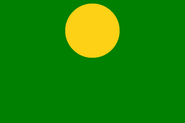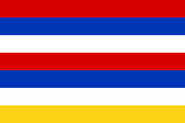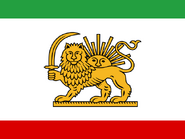The flag of Iran consists of three equal horizontal bands of green (top), white, and red; the national emblem (a stylized representation of the word Allah in the shape of a tulip, a symbol of martyrdom) in red is centered in the white band; "ALLAH AKBAR" (God is Great) in white Arabic script is repeated 11 times along the bottom edge of the green band and 11 times along the top edge of the red band.[3]
Symbolism[]
- Green represents Islam.
- White represents peace.
- Red means courage.
The central symbol consists of four crescents and a sword. The four crescents are meant to stand for the word Allah (there is some resemblance to the Arabic writing of it). The five parts of the emblem symbolize the five pillars of Islam. Above the sword (central part) is a tashdid (looks like a letter W). In Arabic writing this is used to double a letter, here it doubles the strength of the sword. The shape of the emblem is chosen to recall a tulip, in memory of the (young) people who died for Iran. It is an ancient belief in Iran, dating back to mythology, that if a young soldier dies patriotically, a red tulip will grow on his grave. In recent years it is considered as the symbol of martyrdom.
These are 22 copies of the Arabic phrase Allahu Akbar meaning "God is greater (than everything)" in the border line of the stripes. They are written in an ancient manner dating back to the first centuries of Islam. According to the constitution of the Islamic Republic of Iran, the number 22 was chosen because the Islamic Revolution (known as the 1979 revolution in western chronology) overthrew the previous regime on the 22nd of the 11th month (Bahman) of the Iranian Calendar.[4]
History[]
Iran's Lion and Sun emblem was displayed on a flag as early as the 15th century, and in the late 19th century the colors green and red were added as a border to a white flag bearing those symbols. After the granting of the constitution of 1906, a tricolor typical of the national flags of many other countries was officially recognized for Iran. Its horizontal stripes of green-white-red were associated, respectively, with the Islamic faith of the country, peace, and valor. Emblazoned in the center of the white stripe was the Lion and Sun; additional symbols (the imperial crown and a wreath) were added for special purposes such as the naval ensign. Over subsequent decades, many artistic variations were made to these symbols. In 1979 the fundamentalist religious movement led by Ayatollah Ruhollah Khomeini overthrew the Shah and his government and altered the national flag.[2]
References[]
Asia
|
|---|
| Nations Transcontinental Nations Nations with limited/no recognition Territories |
















